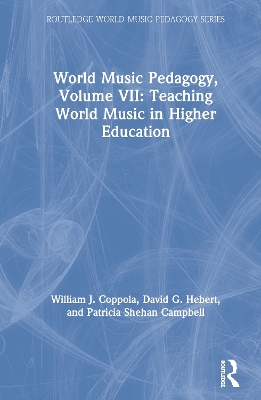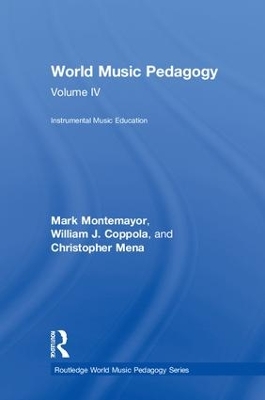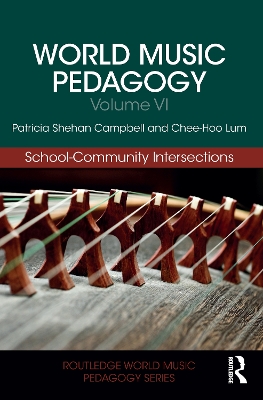Routledge World Music Pedagogy
3 total works
World Music Pedagogy, Volume VII: Teaching World Music in Higher Education
by William J. Coppola, David G Hebert, and Patricia Shehan Campbell
World Music Pedagogy, Volume VII: Teaching World Music in Higher Education addresses a pedagogical pathway of varied strategies for teaching world music in higher education, offering concrete means for diversifying undergraduate studies through world music culture courses. While the first six volumes in this series have detailed theoretical and applied principles of World Music Pedagogy within K-12 public schools and broader communities, this seventh volume is chiefly concerned with infusing culture-rich musical experiences through world music courses at the tertiary level, presenting a compelling argument for the growing need for such perspectives and approaches.
These chapters include discussions of the logical trajectories of the framework into world music courses, through which the authors seek to challenge the status quo of lecture-only academic courses in some college and university music programs. Unique to this series, each of these chapters illustrates practical procedures for incorporating the WMP framework into sample classes. However, this volume (like the rest of the series) is not a prescriptive "recipe book" of lesson plans. Rather, it seeks to enrich the conversation surrounding cultural diversity in music through philosophically-rooted, social justice-conscious, and practice-oriented perspectives.
World Music Pedagogy, Volume IV: Instrumental Music Education
by Mark Montemayor, William J. Coppola, and Christopher Mena
World Music Pedagogy, Volume IV: Instrumental Music Education provides the perspectives and resources to help music educators craft world-inclusive instrumental music programs in their teaching practices. Given that school instrumental music programs-concert bands, symphony orchestras, and related ensembles-have borne musical traditions that broadly reflect Western art music and military bands, instructors are often educated within the European conservatory framework. Yet a culturally diverse and inclusive music pedagogy can enrich, expand, and transform these instrumental music programs to great effect.
Drawing from years of experience as practicing music educators and band and orchestra leaders, the authors present a vision characterized by both real-world applicability and a great depth of perspective. Lesson plans, rehearsal strategies, and vignettes from practicing teachers constitute valuable resources. With carefully tuned ears to intellectual currents throughout the broader music education community, World Music Pedagogy, Volume IV provides readers with practical approaches and strategies for creating world-inclusive instrumental music programs.
World Music Pedagogy, Volume VI: School-Community Intersections
by Patricia Shehan Campbell and Chee-Hoo Lum
World Music Pedagogy, Volume VI: School-Community Intersections provides students with a resource for delving into the meaning of "world music" across a broad array of community contexts and develops the multiple meanings of community relative to teaching and learning music of global and local cultures. It clarifies the critical need for teachers to work in tandem with community musicians and artists in order to bridge the unnecessary gulf that often separates school music from the music of the world beyond school and to consider the potential for genuine collaborations across this gulf.
The five-layered features of World Music Pedagogy are specifically addressed in various school-community intersections, with attention to the collaboration of teachers with local community artist-musicians and with community musicians-at-a-distance who are available virtually. The authors acknowledge the multiple routes teachers are taking to enable and encourage music learning in community contexts, such as their work in after-school academies, museums and libraries, eldercare centers, places of worship, parks and recreation centers, and other venues in which adults and children gather to learn music, make music, and become convivial through music
This volume suggests that the world's musical cultures may be found locally, can be tapped virtually, and are important in considerations of music teaching and learning in schools and community contexts. Authors describe working artists and teachers, scenarios, vignettes, and teaching and learning experiences that happen in communities and that embrace the role of community musicians in schools, all of which will be presented with supporting theoretical frameworks.


